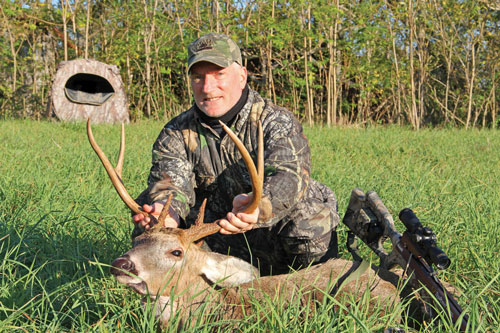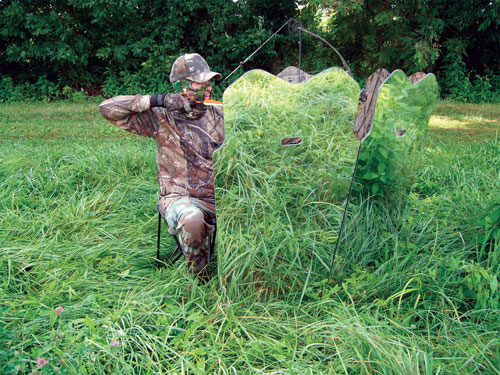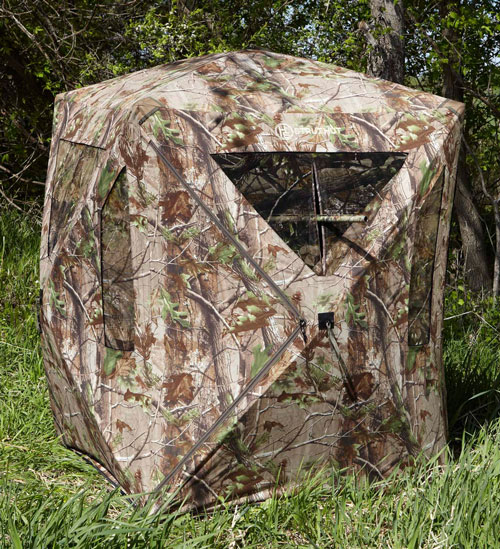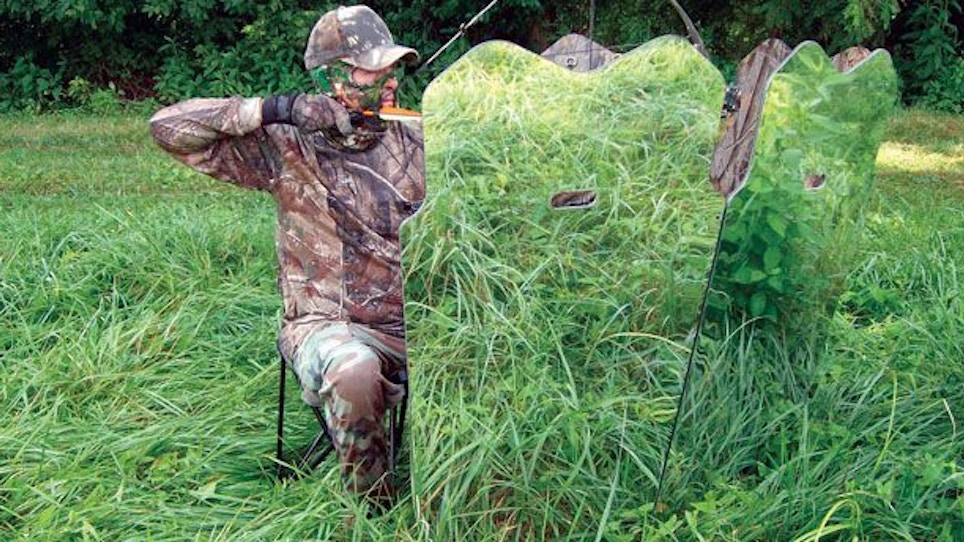 There’s no question Rick White would prefer to be up in a tree when he’s chasing his favorite game animal. Elevation affords him a better view of his surroundings and keeps his scent up off the ground. But sometimes the Cedar Rapids, IO, resident just doesn’t have that option.
There’s no question Rick White would prefer to be up in a tree when he’s chasing his favorite game animal. Elevation affords him a better view of his surroundings and keeps his scent up off the ground. But sometimes the Cedar Rapids, IO, resident just doesn’t have that option.
“I’ve been in many situations where there is no tree where I needed to be hunting,” says White, a full-time pro staff member with Hunter’s Specialties. “But a ground blind will give me a chance to hunt a deer that I might not otherwise have.”
Contrary to what many hunters think, a ground blind won’t make you invisible, and it won’t contain your scent. In fact, the blind itself will likely have its own unnatural odors. Arguably, it’s impossible to mask all odors, but White will spray his blinds — and himself — with Hunter’s Specialties Scent-Away each time he puts out a blind.
“Even if you are particular about scent control like I am, you still need to pay attention to wind direction or there’s a chance you’ll get busted,” he says. “I’ve had it happen on many occasions.”
A blind will, however, allow you to hunt in comfort and out of a bitter-cold wind or a pounding rain — luxuries a tree stand can’t offer. In fact, a strong wind can not only make a tree stand unsafe, it can turn a “gimme” shot into an impossible one. Ever try holding a bow steady in a tree during a raging wind storm? You can sit in a folding chair in a ground blind, even fire up a portable heater if you like, and you can fidget, wiggle and squirm with little risk of spooking approaching deer.
That is, as long as you hunt smart and keep your blind away from the deer you plan to hunt. There is no “right” location to place a blind — where you put it has as much to do with the general area you plan to hunt and the tool you plan to hunt with. Bowhunters, of course, need to be closer to their quarry, but not too close.
“You don’t want to put it right on a deer trail, for instance. I like to back off far enough that I can make the shot without worrying about spooking a deer when I’m drawing my bow or aiming my gun,” notes White.
Choose The Right Blind
Ground blinds come in a variety of shapes and sizes, from palatial two-man blinds tall enough for a basketball player to stand in to cramped pop-ups that offer little in the way of elbow room. Those smaller blinds, however, do have their advantages. They are lightweight and they can set up in a matter of seconds, allowing you to pick up and move on a whim. While most deer hunters stay put, some like to run-and-gun, so to speak, particularly during the pre-rut period when it can pay dividends to stay mobile.
If you have no plans to move, go big, or at least big enough to give yourself enough room to stash your gear out of the way so you can turn, draw and shoot without bumping the walls or ceiling. Big blinds are heavier, but the weight of each blind depends primarily on a couple of factors — the size of the frame and the thickness or density of the blind shell.
The lightest blinds are made with spring steel loops that can be twisted into a circle, folded up and carried in a small pack. They set up in a just a few seconds, but it can take a little practice to fold them back up for transport or storage. These types of blinds are also the least expensive, mostly because they are made from thinner material and have few features. The primary disadvantage of spring-steel blinds is that they tend to be flimsy. A light breeze can flutter the flaps and push the blind around, which can spook nearby game. Most come with stakes to minimize this, but they won’t stop it completely.
Pole, or frame, blinds are similar to the sun shades commonly found on beaches and at picnics and tailgate parties. The consist of a collapsible, accordion-style frame that sets up and takes down relatively quickly. However, the blind material itself must be placed over the frame — a task that can take more than a few minutes. They are sturdy, though, and tend to stand up to the elements better than other types of blinds. Pole-type blinds are often adjustable, allowing you to set the height to your liking. They can also be used on hills.
 The third type are the most popular and for many hunters, the most practical. They include a strong, collapsible frame wrapped by an attached camouflage shell and they set up and take down in just a few minutes. They are sturdy and come in a variety of shapes and sizes.
The third type are the most popular and for many hunters, the most practical. They include a strong, collapsible frame wrapped by an attached camouflage shell and they set up and take down in just a few minutes. They are sturdy and come in a variety of shapes and sizes.
Perhaps the most unique blind is one made from mirror panels that angle slightly downward, creating a mirror image of the ground that surrounds the blind. Ghost Blinds (www.ghostblind.com; 877-751-4868) offer a six-panel and a four-panel model and both fold for easy transport.
“The best way to find the right one is to try a couple of different blinds. Most of the larger outdoor stores have blinds set up for that reason,” explains White. “Climb inside and spend a few minutes doing the same things you’d do if you were hunting.”
That can mean everything from sitting in a chair and stretching your legs to opening and closing windows and even moving as if you were drawing a bow or raising a gun to shoot. If the store allows it, take the blind down and set it back up. Not only will that show you the basic quality of the product, it will give you an idea of what you might be doing in the dark come hunting season.
While many hunters like the shoot-through mesh windows that come standard with many blinds, White doesn’t care for them. It’s not that he doesn’t appreciate the shoot-through mesh; it’s just that he would prefer shooting through an open window.
“I just find it difficult to get a good sight picture through it, especially when I’m using a bow. I want to be able to see as best I can, and the mesh doesn’t give me that opportunity,” he says.
Most ground blind designers are also hunters and therefore understand the need for a quiet window. That’s why some blind windows attach to the canopy with magnets instead of Velcro or zippers, both of which can be noisy. Not all blind windows come with magnet closure systems, though, so check before you buy if that’s a feature you must have.
White also likes blinds that have loops sewn on the outside. Those loops are designed to hold limbs and other brush, allowing you to better conceal the blind.
Use It Properly
No matter what blind you choose, make sure you avoid some common mistakes. White says turkeys will ignore a blind that’s placed in a field those same birds have been using all spring. They act as if it was invisible or was a permanent part of the landscape. Deer, on the other hand, are much more wary and are likely to spook at the sight of something new. That’s why White will place his blind in the spot he plans to hunt weeks before he actually hunts out if it. Doing so gives the animals time to get used to it; they’ll eventually ignore it just as they ignore other sights that aren’t part of the natural landscape.
“If that’s not an option, I’d do everything I could to hide the blind,” he says. “You can either tuck it back in some cover or brush it up with limbs and other vegetation — anything that will help conceal it,” he said.
 If he does set it out well before he plans to hunt out of it, White makes sure he leaves a window open.
If he does set it out well before he plans to hunt out of it, White makes sure he leaves a window open.
“If you leave it closed and then open it when you get there, the deer will see a big black hole that wasn’t there before. I’ve done that, and there’s no question the deer notice something’s different,” he adds.
Leaving two or more windows open, however, invites trouble. The daylight behind the blind will expose any movement you make inside, possibly alerting deer to your presence. That’s why White always keeps the windows behind him closed.
Many hunters wear camouflage when they sit in a blind, but White instead prefers to wear black. Of course, he’ll wear blaze orange if he’s legally obligated to do so, but a black sweatshirt or coat conceals a hunter better than camouflage. That’s because the dark clothing matches the dark interior of a blind.
It’s not mandatory, but then neither is sitting in a ground blind the next time you chase whitetails. You will, however, have the upper hand when the buck of a lifetime walks within gun or bow range.
Trick My Blind
By itself, a ground blind is an essential piece of gear for any hunter who can’t, or won’t, climb a tree. Thankfully, though, some companies sell accessories to help you hunt in comfort. Ameristep and Primos, for example, offer LED lights. Blinds can be pitch black inside, even during daylight hours. Both companies also sell storage units that hang from the inside wall. They can help you keep your gear organized and available when you need it most. No more shuffling through darkness to find the binoculars or your release.
Ameristep sells a portable fan/light combination for those hot early-season bow hunts. You can also buy bow and gun holders and blaze orange covers that span the entire top of the blind. Some states require orange on the outside of ground blinds during firearms seasons. You’ll also want to bring a folding chair.






